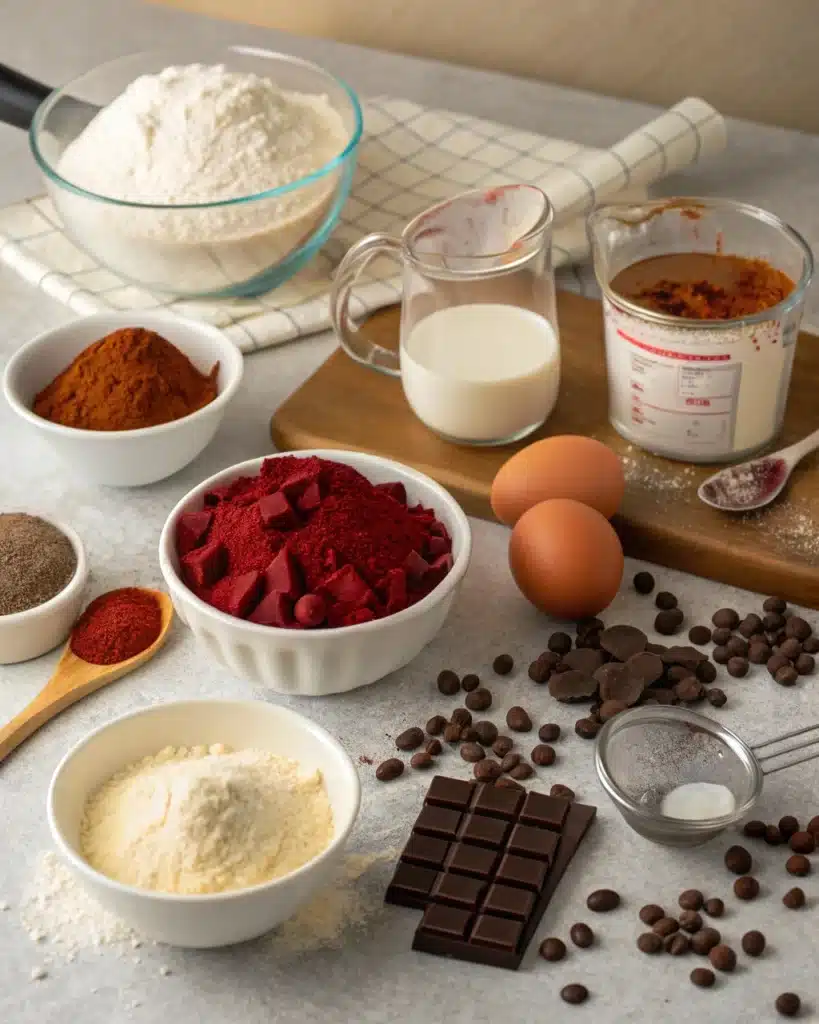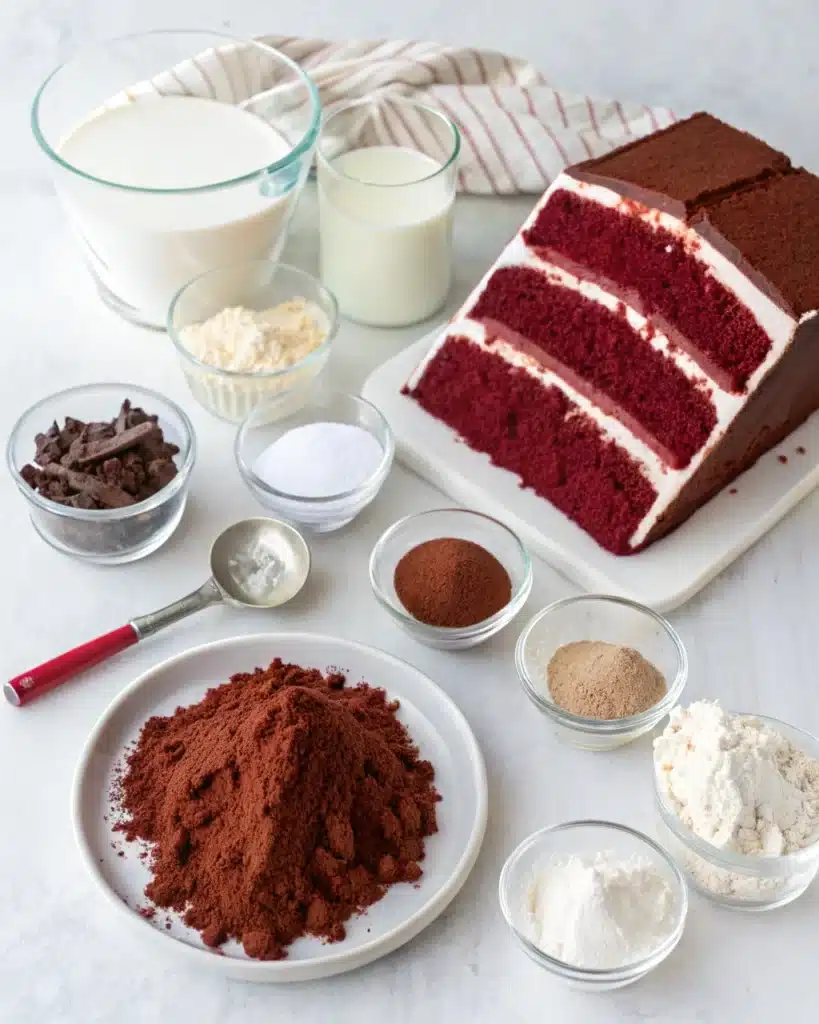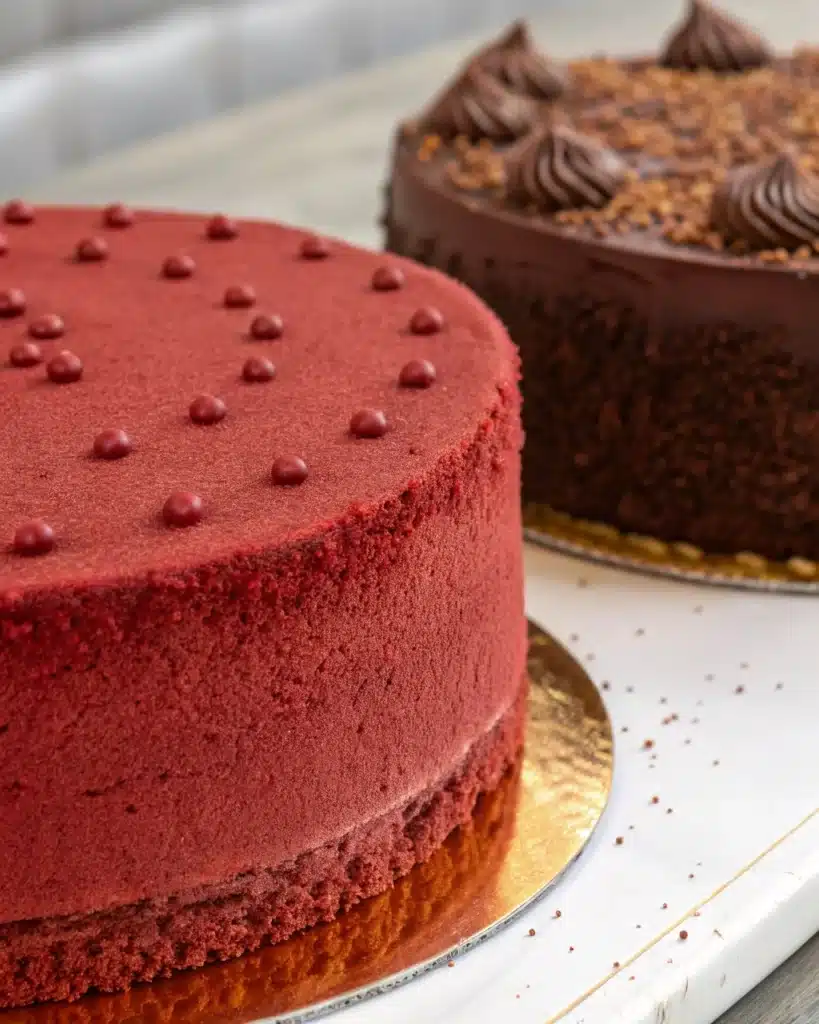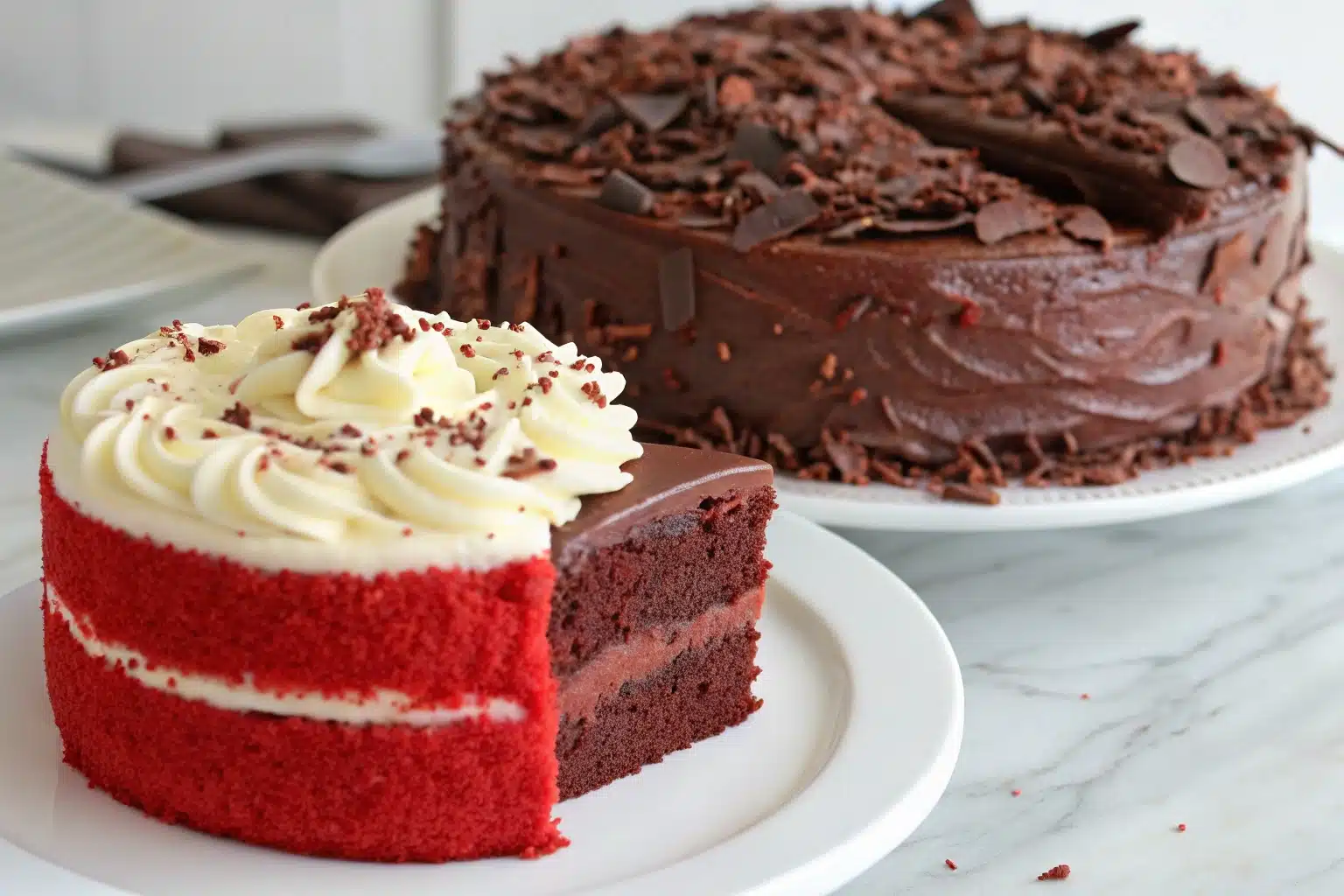Introduction
As someone who’s spent countless hours baking and taste-testing, the debate of whether there’s a true flavor difference between red velvet and chocolate cake is one I’ve encountered time and again. At first glance, red velvet may look like a colorful version of chocolate cake, but the flavor tells a different story. If you’ve ever wondered what sets these two cakes apart, you’re not alone. Let’s dive in to uncover the distinctions in ingredients, texture, and flavor profiles.
Understanding the Basics of Red Velvet and Chocolate
What is Red Velvet Cake?
Red velvet cake is a classic dessert that dates back to the 19th century. Its name comes from its velvety texture and the deep reddish hue that gives it a bold visual appeal. Traditionally, the reddish color came from a natural reaction between cocoa powder and acidic ingredients like buttermilk and vinegar. Nowadays, food coloring is often added for a more vibrant red.
The key ingredients of red velvet cake include:
- A small amount of cocoa powder (usually 1-2 tablespoons).
- Buttermilk and vinegar, which create a tangy undertone.
- Cream cheese frosting, a traditional pairing that enhances the flavor profile.
Red velvet is beloved for its subtle cocoa flavor, balanced by a tangy sweetness and an incredibly soft texture.
What is Chocolate Cake?
Chocolate cake has been a dessert favorite for centuries, with its roots tracing back to the discovery of cocoa in Mesoamerica. Unlike red velvet, chocolate cake relies heavily on cocoa powder or melted chocolate for its deep, rich flavor.
Key ingredients in chocolate cake include:
- A larger amount of cocoa powder or melted chocolate.
- Butter or oil, which contributes to a moist texture.
- A range of frostings, including buttercream, ganache, or whipped cream.
Chocolate cake is often described as bold and decadent, making it a timeless choice for celebrations.

Key Ingredients That Differentiate the Two
Cocoa Powder’s Role in Red Velvet and Chocolate
One of the biggest differences between red velvet and chocolate cake lies in the amount of cocoa powder used. Chocolate cake relies heavily on cocoa powder or melted chocolate to create its deep, rich flavor. Depending on the recipe, chocolate cakes can contain anywhere from 1/4 to 1/2 cup of cocoa powder—or more if dark chocolate is used.
In contrast, red velvet cake uses a much smaller quantity of cocoa powder, usually 1-2 tablespoons. This small amount contributes a subtle cocoa undertone without overpowering the tangy and sweet flavors unique to red velvet.
Acidic Ingredients in Red Velvet
Another key difference is the presence of acidic ingredients in red velvet cake. Traditional recipes include buttermilk and vinegar, which not only give red velvet its signature tang but also react with baking soda to create a light, fluffy texture. These acidic ingredients are absent in chocolate cake, which instead uses milk or water as the liquid base.
The acidity also plays a role in the cake’s reddish hue. Natural cocoa powder contains anthocyanins, which react with acids to produce a reddish tint. While modern recipes often rely on food coloring for a vibrant appearance, the acidity is still essential for red velvet’s signature flavor and texture.
Coloring Agents: Natural and Artificial
Red velvet’s striking red color is another defining characteristic. Originally, the red tint was the result of natural reactions between cocoa powder and acidic ingredients. However, modern red velvet recipes often include red food coloring to achieve a consistent and bold appearance.
Chocolate cake, on the other hand, is defined by its deep brown color, derived entirely from cocoa powder or melted chocolate. There are no added coloring agents, as the focus is solely on enhancing the rich chocolate flavor.
Flavor Profiles of Red Velvet vs. Chocolate
How Does Red Velvet Taste?
Red velvet cake has a unique flavor that sets it apart from other cakes. It combines subtle cocoa notes with a tangy sweetness that comes from its acidic ingredients, such as buttermilk and vinegar. This tanginess gives red velvet its signature flavor, which is both refreshing and indulgent.
The light use of cocoa powder adds just a hint of chocolate flavor, but it’s not as bold or rich as in a traditional chocolate cake. Instead, the flavor is balanced and mild, making it an appealing choice for those who enjoy a touch of chocolate without it being overwhelming.
How Does Chocolate Cake Taste?
Chocolate cake is rich, bold, and deeply satisfying. Its flavor depends on the quality and type of cocoa or chocolate used. For example:
- A cake made with natural cocoa powder will have a lighter, more acidic chocolate flavor.
- Cakes made with Dutch-processed cocoa or melted chocolate offer a richer, smoother, and sometimes darker taste.
Chocolate cake is sweeter than red velvet, with a more intense cocoa flavor that takes center stage. It’s designed to be decadent, and variations like dark chocolate or flourless chocolate cakes can amplify its richness.
Side-by-Side Flavor Comparison
When tasted side by side, the flavor differences between red velvet and chocolate cake become apparent:
- Sweetness: Chocolate cake tends to be sweeter than red velvet.
- Tanginess: Red velvet stands out for its slightly tangy, creamy flavor, thanks to the buttermilk and vinegar. Chocolate cake, on the other hand, lacks this tang.
- Cocoa Flavor: While both cakes use cocoa powder, red velvet’s cocoa flavor is much subtler. Chocolate cake delivers a bold chocolate experience.
- Aftertaste: Red velvet leaves a creamy, tangy aftertaste, while chocolate cake has a lingering richness.
Ultimately, the choice between these two cakes comes down to personal preference: red velvet is a balanced, tangy-sweet option, while chocolate cake is a more intense, cocoa-forward dessert.
Texture Differences Between the Two Cakes
Why Red Velvet is Softer and Smoother
Red velvet cake is renowned for its smooth, velvety texture, which is where it gets its name. This softness can be attributed to a combination of unique ingredients:
- Buttermilk and Vinegar: These acidic ingredients react with baking soda, creating bubbles that make the cake light and airy.
- Lower Cocoa Content: The reduced amount of cocoa powder contributes to a finer crumb compared to the denser texture of chocolate cake.
- Oil or Butter: Many red velvet recipes use oil instead of butter, which results in a moist and tender cake.
The result is a cake that practically melts in your mouth, with a texture that is slightly smoother than chocolate cake.
Chocolate Cake’s Denser Crumb
Chocolate cake, in contrast, typically has a denser crumb. This is due to its higher cocoa content, which adds richness but also makes the texture more compact. Additionally:
- Butter vs. Oil: Many chocolate cake recipes use butter, which enhances flavor but can make the cake slightly heavier.
- Egg Content: Depending on the recipe, chocolate cake often uses more eggs, which contribute to its structure and density.
- Moisture Levels: Chocolate cake can vary in texture depending on whether milk, water, or even coffee is used as the liquid base.
While chocolate cake can also be moist, it lacks the characteristic lightness of red velvet. However, its denser texture makes it ideal for layering or supporting rich frostings, like ganache.
Side-by-Side Texture Comparison
- Red velvet: Soft, light, and smooth with a fine crumb.
- Chocolate: Dense, rich, and slightly heavier with a thicker crumb.
Both textures have their own charm, but red velvet’s airy softness appeals to those who prefer a lighter cake, while chocolate cake’s density is perfect for those craving a more substantial dessert.

Red Velvet vs. Chocolate in Popular Culture
Why Red Velvet is Trending
In recent years, red velvet has become a cultural phenomenon. Its vibrant red color and luxurious texture have made it a favorite for celebrations and desserts with a wow factor. From weddings to birthdays, red velvet has become synonymous with sophistication.
The rise of Instagram and food photography has also played a significant role in its popularity. The striking red hue contrasts beautifully with white cream cheese frosting, making it a highly photogenic dessert. Beyond cakes, red velvet now appears in:
- Cupcakes: Perfect for individual servings at events.
- Cookies: Combining the tangy-sweet flavor with a chewy texture.
- Ice Creams and Cheesecakes: Creative twists on the classic recipe.
Chocolate: A Timeless Classic
While red velvet may be trending, chocolate cake is a timeless classic that never goes out of style. Loved across generations and cultures, chocolate cake has remained a staple for all kinds of occasions—from casual dinners to grand celebrations.
Its versatility has kept it in the spotlight, with countless variations:
- Dark chocolate cake for a sophisticated flavor.
- Flourless chocolate cake for a rich, dense texture.
- Molten lava cakes for an indulgent dessert experience.
Chocolate’s universal appeal has even extended beyond cake into cookies, brownies, and mousse. Unlike red velvet, chocolate cake has no need for trends—it’s a dessert icon that continues to delight.
Which Cake Reigns Supreme?
In popular culture, red velvet represents indulgence and elegance, while chocolate cake symbolizes comfort and nostalgia. Both hold a special place in dessert history and on our plates.
Nutritional Differences Between Red Velvet and Chocolate
Calorie Count and Sugar Content
When it comes to nutrition, both red velvet and chocolate cakes are indulgent treats, but their calorie content and sugar levels can vary depending on the recipe.
- Red Velvet Cake:
The addition of buttermilk, vinegar, and food coloring does not significantly increase the calorie count. However, the cream cheese frosting, which is a standard pairing, is rich in fat and sugar. A typical slice of red velvet cake with cream cheese frosting contains around 400–450 calories, depending on serving size. - Chocolate Cake:
Chocolate cake is often slightly higher in calories because it uses more cocoa powder or melted chocolate, which increases the fat content. Additionally, chocolate ganache or buttercream frosting adds extra calories. A slice of chocolate cake can range from 450–500 calories, depending on the recipe.
Both cakes are high in sugar, with an average of 30–40 grams per serving, making portion control essential for those watching their sugar intake.
Nutritional Value of Cocoa in Both Cakes
Cocoa powder, a common ingredient in both cakes, does provide some health benefits, such as being rich in antioxidants and magnesium. However:
- Chocolate Cake: Contains a higher cocoa content, offering more antioxidants compared to red velvet.
- Red Velvet Cake: Has a lower cocoa content, so its antioxidant benefits are minimal.
Are Either Healthier?
Neither cake is particularly healthy, but chocolate cake edges ahead slightly in terms of nutritional benefits due to its higher cocoa content. However, red velvet’s use of buttermilk does provide a small amount of calcium and protein.
If you’re looking for a slightly lighter option, red velvet may feel less heavy due to its lighter texture, even if the calorie count is similar.
Pairing Frostings with Red Velvet and Chocolate
Traditional Cream Cheese Frosting for Red Velvet
One of the defining characteristics of red velvet cake is its pairing with cream cheese frosting. The tangy, slightly sweet flavor of cream cheese frosting perfectly complements the subtle cocoa notes and tanginess of red velvet.
- Ingredients in Cream Cheese Frosting:
Cream cheese frosting typically includes cream cheese, powdered sugar, butter, and vanilla extract. Some recipes add a splash of lemon juice to enhance the tanginess further. - Why It Works with Red Velvet:
The smooth, creamy texture and mild sweetness balance the acidic notes of the buttermilk and vinegar in the cake. The frosting also adds a decadent richness that elevates the cake’s overall appeal.
Chocolate Ganache and Buttercream for Chocolate Cake
Chocolate cake is incredibly versatile when it comes to frostings. The rich flavor of chocolate pairs well with various frosting types, but two stand out:
- Chocolate Ganache: A luxurious, glossy frosting made from melted chocolate and heavy cream. Ganache intensifies the chocolate flavor of the cake and adds a velvety finish.
- Buttercream Frosting: Sweet and creamy, buttercream can be flavored with vanilla, cocoa, or even espresso to complement the chocolate cake. It’s lighter than ganache but still indulgent.

Pairing Options Based on Occasion
- For Red Velvet: Cream cheese frosting is the traditional choice, but for a twist, try white chocolate frosting or mascarpone frosting
- For Chocolate Cake: Chocolate ganache is perfect for a sophisticated dessert, while buttercream is ideal for birthday cakes. For adventurous palates, peanut butter frosting or salted caramel frosting can add a unique spin.
Which Frosting Wins?
It depends on the cake! Cream cheese frosting is iconic for red velvet, while chocolate cake offers more flexibility with rich or light frostings.
FAQ
Do red velvet and chocolate taste the same?
No, red velvet and chocolate cakes do not taste the same. While both contain cocoa powder, red velvet has a much milder chocolate flavor. The tangy notes from the buttermilk and vinegar give red velvet a unique flavor profile that sets it apart from the rich, bold taste of chocolate cake.
What is the actual flavor of red velvet?
The flavor of red velvet is a combination of subtle cocoa, tanginess from buttermilk and vinegar, and sweetness from the cake and frosting. Its signature cream cheese frosting adds a creamy, tangy finish that enhances the overall flavor. Red velvet is often described as balanced and mild rather than intensely sweet or chocolaty.
What’s the difference between chocolate and red velvet cookies?
Chocolate cookies focus on bold, rich cocoa flavors, often using dark or semi-sweet chocolate for an intense taste. Red velvet cookies, however, are softer and have a more delicate flavor. They use less cocoa and often include tangy elements like buttermilk or vinegar, mimicking the cake’s flavor. Additionally, red velvet cookies are typically paired with cream cheese or white chocolate chips for added sweetness.
Is red velvet closer to chocolate or vanilla?
Red velvet is closer to vanilla than chocolate in terms of flavor. While it does contain cocoa powder, the small amount used gives it only a hint of chocolate. Its overall flavor is lighter and more complex, with tangy, sweet, and creamy notes taking center stage.
Here are six relevant internal links from Citrus Recipes for red velvet and chocolate-related content:
- Why Red Velvet Cake Is Expensive
- What’s the Difference Between Chocolate and Red Velvet Cookies?
- Chocolate Cherry Cake Recipe
- Red Velvet Cookies Recipe
- Vanilla Cake vs. Red Velvet
- Is Red Velvet Just Chocolate and Vanilla Cake?
These links align well with the topic, covering red velvet and chocolate comparisons, recipes, and unique perspectives.

